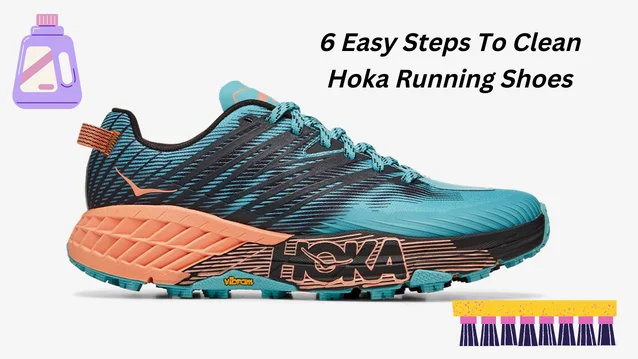Running shoes has always been an in-demand item for over a century now and one of the best companies to produce them is Hoka. Founded in 2009 in Annecy, France, and had been based in Richmond, California before it was acquired by Deckers Brands in 2013
If you own a pair of HOKA shoes you are probably a serious runner but the question that arises in your mind that how to keep your HOKA shoes in the best condition?
The best way to clean HOKA shoes is to hand wash them with warm water, soap, and a sponge. After washing let your HOKA’s air dry in a well-ventilated area away from direct sunlight or a source of excessive heat such as a radiator.
How to Clean and Dry Wet Your Hoka Running Shoes in 6 Easy Steps
You can clean and maintain your Hoka running shoes just good with everyday household items, indeed if they’re drenched or muddy. The process can be a bit labor- ferocious, but your shoes will last significantly longer with proper cleaning.
Remember that using a washing machine or dryer for your handling shoes will progress them rapidly, and take the following way
Step 01-Disassemble Your Shoes:
The first step is to remove liners, insoles, and laces in the beginning.
Step 02-Wash Your Laces:
Throw the laces into the laundry with your running clothes, and wash them on the cold setting with your regular soap( Pro Tip stuff them into a sock so they don’t get lost or tangled). Just remember to remove them from the cargo before you transfer them to the dryer
Step 03-Remove mud and dirt:
Remove Excess Mud and Dirt from the Shoe Outers, Fifers with a dry paper kerchief also with a dry toothbrush for lesser detail, and remove slush and dirt externally external areas of your shoes; if your shoes are exceptionally muddy, you might want to let the mud dry before wiping, as crusted slush comes out easier in clumps.
Step 04-Scrub Clean:
Mix a small dab of your chosen soaping agent( natural color-free soap, dish cleaner, or certainly dandruff soap can all work acceptably) into the cool water, and gently work into dirty areas of the shoes and insoles with the toothbrush until there’s a lather; keep going until the dirt is gone, and remove dirty water with a dry kerchief or rag as you go.
Step 05-Wipe off (With Damp Rag):
Now wipe off all remaining soap lather with a towel or rag moistened with cold water.
Step 06-Leave your shoes to dry off:
The next step is to leave your shoes to dry off (including insoles) should now be dirt-free, if enough wet; spot them with a dry cloth until they’re no longer sopping, and stuff your shoes with newsprint to let them dry overnight (pro tip: keep your insoles separate, and don’t leave your shoes to dry outside or try to speed the process with a heat source- both sun and direct heat can warp them); for added odor protection, include a dryer distance or a light dusting of baking soda with your wadding.
However, follow the above steps to clean them, but use the final “ spin ” setting on your washing machine a few times to dry your shoes using centrifugal force, If for some reason you have to completely clean and dry your shoes in lower than 12 hours. detail, selective uses of “ air dry ” or “ gentle ” setting on a dryer can work in a pinch as well.
Tips to follow:
Not all HOKA running shoes are made of the same material.
While the above “how to” work well enough with nearly all shoe materials, you might want to introduce a few modifications based on the materials your HOKA shoes are made of.
Here are some cleaning tips for different shoe materials:
• Mesh cleaning: Mesh is light, permeable, and quick-drying, but also vulnerable to rasping under harsh scrubbing. To avoid this, apply minimum force( suppose repetitious dabbing rather than wiping), and use a softer-bristle toothbrush if possible.
• Suede or Nubuck cleaning: Suede and nubuck are durable premium “ natural ” leather types vulnerable to humidity. For this reason, suede and nubuck areas are best cleaned once the shoe is completely dried. spot aggressively with a dry towel or rag, also after the suede or nubuck dries completely, use a dry encounter to remove dirt, followed by a direct stain treatment application, followed by another round of blotting. You may also want to buy suede- or nubuck-specific cleaning results or waterproofing agents.
• How to Clean Leather: Standard leather is a durable material option that’s great at keeping water out of handling shoes and boots and is a breath to clean. Just follow the below-listed method, wipe your shoes down when you’re done, and make sure to introduce an odor-fighting agent like incinerating soda or a teetotaler distance to the dry wadding you stuff into them.
• How to clean canvas and natural fiber: Most running shoes are made with synthetic fabrics to avoid the danger of shrinking, but if areas of your shoes have natural fabric, you can drop them clean with a soft bristle brush. Dip it into warm water and baking soda admixture( 11 is fine, it won’t take important). In all cases, remember that the rolling you use to help dry your shoes has more than one purpose- not only does it dry the fabric and soak up odor, but it also helps your shoes maintain their shape as they dry.
HOKA Shoe Care and Weatherproofing:
Preventative care options similar to weatherproofing can extend the life of your HOKA footwear.
Waterproofing Spray results Once your shoes are completely dry, spot them with a trusted waterproofing result. You’ll need to let the spray itself dry before your shoes can be regarded as weatherproofed, but once you do, water and mud should be a lot easier to clean.
Odor Prevention Rainwater and mud puddles will accelerate the mold, mildew, and stink caused by bacteria. Your own bottom sweat can also cause odor. Try an occasional light dusting of incinerating soda pop even on dry shoes.
Don’t Start Wet While not at each necessary, rotating multiple pairs of running shoes with proper care can help elongate the use you get out of each. However, avoid running in shoes that are still wet from the last use, If at all possible.
What Is Hoka?
HOKA stands for “fly over earth” It’s not only highly cushioned but also feather light and permeable, making it a comfortable option for long-distance runs. Other notable features include a compression-molded midsole, inner heel support, and HOKA’s Meta-Rocker technology, which is designed to propel you forward and encourage a more natural stride.
Why do podiatrists recommend HOKA?
Dr. Jacqueline Sutera, a New York City-based podiatrist said that they provide comfort, support, and shock absorption which makes them a good choice for frequent walkers or anyone whose job requires them to stand for the majority of the day.
Can you wash and dry HOKA’s?
When washing your shoes, always follow the care instructions. Generally, shoes should be washed on a cold, gentle cycle to help disengagement and damage. After washing, air dry your shoes overnight. Exposing your shoes to high heat in the dryer can beget them to shrink and become damaged.
How do you clean white HOKA’s?
Warm soapy water: Good for cleaning shoes made from almost any material, just add about one teaspoon of dishwashing liquid to one cup of warm water and stir. Using a cloth or toothbrush, gently scrub the shoe until clean, wipe off any excess water and leave to air dry for several hours.
Conclusion:
Cleaning Hoka shoes is essential to maintain their performance and appearance, ensuring they remain in top condition for your active lifestyle. Regular care involves removing dirt and debris, using mild soap and water for deeper cleaning, and allowing them to air dry away from direct sunlight to prevent damage. By following these simple steps, you can extend the life of your Hoka shoes and keep them looking fresh and ready for your next adventure. I hope this quick guide is sufficent in how to clean Hoka running shoes.


